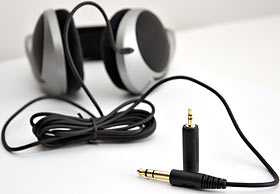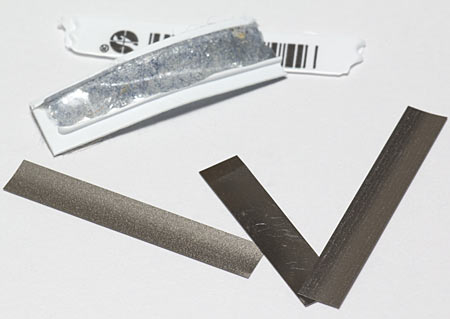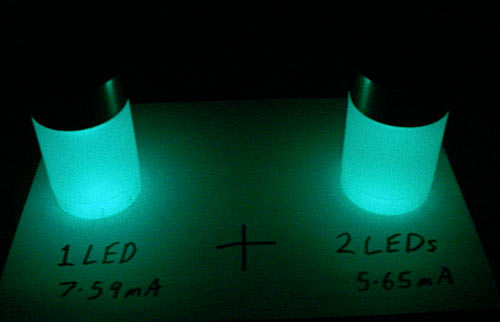A reader writes:
Sometimes when I plug in my headphones it seems as if I'm not receiving any vocals. Its still stereo, but I find that the headphone jack isn't completely in. What's going on here? And why does it work so effectively at removing vocals?
Simon
The quick answer: You're hearing the two stereo channels mixed, with one of them out of phase with the other.
I can't for the life of me figure out how this happened, though. In the interminable rambling below I talk about a couple of other crossed connections that can, and often do, happen, but unless there's a bit of wire stuck in the headphone socket or some other such oddity, I don't know how you could have the exact symptoms you report. Unless, of course, what you think you're hearing isn't what's actually happening, which is eminently possible since the ear is as easy to fool as the eye.
Anyway, mixing one stereo channel with an opposite-phase version of the other channel means that any component of the musical mix which is essentially monophonic - in the middle of the stereo "soundstage", the same on both channels - will be cancelled out.
Singing in popular music is, usually, pretty much in mono in the middle of the stereo mix. So mixing one side with a phase-flipped version of the other side will cancel out said singing; all you'll hear of the singer is any stereo reverb or difference in volume between the two sides (a.k.a. panning).
This technique, called Out Of Phase Stereo or OOPS, is used in this simplest form by old and/or cheap karaoke machines that let you "mute" the vocals on normal music, so you don't need a special vocal-less karaoke version of every song.
Simple OOPS doesn't work very well, because vocals are seldom exactly in mono (they usually have some stereo reverb, for instance), and if any other component of the mix - drums, bass, whatever - is also mono, then that'll be muted too. Smarter OOPS vocal-muting tries to identify and mute only the vocals, based on the pitch and possibly even the timbre of the sound.
This weirdness can come about because headphone plugs use TRS (Tip, Ring, Sleeve) connectors. TRS connectors come in a variety of sizes - the big old-fashioned 6.35mm (quarter-inch), the ubiquitous modern 3.5mm (eighth-inch), and the usually unnecessary and irritating 2.5mm (3/32 or 1/10 inch, depending on who you ask). All three-contact audio TRS connectors are, or should be, wired the same way; the tip of the plug is left channel, the ring is right channel, and the sleeve at the base of the plug is a shared ground.
(This sort of cylindrical plug connector should only be called "TRS" if it has these three contacts. Mono-audio cables with the same sort of plug, like for instance guitar leads, omit the ring contact and should therefore be called just "TS" connectors. Connectors with two ring contacts, as for instance used for stereo headsets with a microphone, should be called "TRRS". Sometimes you'll see any plug of this basic form called a "TRS" plug, though, regardless of how many contacts it actually has.)
Most headphones today have a 3.5mm plug; fancier ones...
...come with a 6.35mm adapter for it, too.
Some headphones mix it up a bit. One of these Sennheisers has a simple 3.5mm TRS plug on both ends of its cable, so you can very easily and cheaply replace the cable if it's damaged...
...but the other has a 3.5mm TRS on one end of its cable, and at the other end the cable splits into a pair of 2.5mm TS plugs, one for each side of the headphones.
If a TRS plug isn't fully inserted, contacts on the plug can touch the wrong contacts in the socket.
(This characteristic makes this shape of plug a bad fit for many applications. I once bodged up a two-voltage power-supply connection for an external SCSI drive box for, of course, my Amiga, using a 6.35mm TRS plug and socket. I avoided the dangers of connecting one voltage to the other's contact and the other voltage to the ground contact by only connecting or disconnecting the power supply when everything was turned off. Or, at least, connecting or disconnecting it really fast.)
A partially-inserted TRS plug could, for instance, leave the tip contact on the plug touching the ring contact of the socket, and the plug's ring contact not touching anything, and the sleeve of the plug still touching the sleeve of the socket, because the sleeve is much longer than the other two contacts. This sort of mis-connection will give you the signal meant for your right ear in your left ear, and no sound from the right side of the headphones.
(The sleeve of the plug is connected to the braided or foil shield of the cable, and any or all metalwork on the plug that is not the tip or ring contact will also be connected to the shield - it's all one big sleeve contact, basically. TRS sockets almost always work the same way; the socket has small tip and ring contacts, but the rest of the socket's metal is all sleeve. This makes it very easy for the sleeve of plug and socket to remain connected when the plug isn't all the way in, and if the plug's a long way out of the socket it also makes it pretty easy for the plug's ring contact to touch the socket sleeve contact.)
I encourage readers, by the way, to try this out yourselves; it's pretty much impossible to hurt your headphones or anything you plug them into by only plugging them in half-way. So do that, especially if you find my interminable blather confusing, or just want to see if you can create Simon's symptoms for yourself.
Another mis-connection could have the plug-tip touching the socket-ring, and plug-ring touching socket-sleeve. Now you'll hear the signal meant for the right side through both ears, but it'll sound weird, because it's out of phase, as mentioned above.
This is because the left and right "drivers" of the headphones (the electromagnetic transducers that actually make the sound) are, with this mis-connection, now wired in series, with the wire going "out" of the left driver that's meant to connect directly to the sleeve contact instead only being able to connect to the sleeve through the right driver and the plug's ring contact, thereby feeding the right driver "backwards".
This causes the right side to be out of phase - when the left driver is moving toward your head, the right one should be too, but now its phase is inverted and it's moving away.
There are two reasons why I'm rabbiting on about this stuff at such outrageous length. The first is that basic audio cabling like this is something that almost everybody has to deal with, and it pays to know what connects to what even if you don't intend to be soldering up any cables of your own - though basic soldering is easy to learn, cheap, and can save you quite a bit of money.
(Just yesterday, I turned a couple of not-that-cheap Apple laptop power supplies, one electrically dead and the other with a fractured and fiendish-to-repair MagSafe plug, into one working power supply with an extra-long cable. Even the dodgiest off-brand MagSafe power supplies are about $US20; a genuine Apple one is $79. With basic soldering skills and equipment, this sort of thing is a literal five-minute job.)
The second reason for this ridiculously large post is that phase problems are actually very common in home audio, and not only among people who fix their own headphones and get one set of Profanity-Allowance-consuming minuscule wires backwards.
People have been creating phase problems ever since the invention of stereo, occasionally by mis-connecting a turntable cartridge, but usually by wiring one of their stereo speakers the right way around (red terminal on the amplifier to red terminal on the speaker, and black to black) and the other the wrong way (red to black, black to red). In this case, each speaker actually is playing the signal that it should be, but one is phase-inverted.
(It doesn't really matter whether you've connected red-to-red or the other way around, as long as both speakers are the same. In theory, having both out of phase with the way they should be, but in phase with each other, could cause an audible difference, but in practice it's only detectable by golden-eared audiophiles who see no need for tiresome things like blinded tests.)
If you've got two working ears, you definitely can hear when stereo has one side out of phase. It's hard to describe, though; it's sort of like having a head cold that's blocked one of your Eustachian tubes but not the other, or how things sound when an air-pressure change has popped only one of your ears. Here's a page that explains this, with nifty audio samples including one (MP3 link) that should sound mono in the first half and out-of-phase pseudo-stereo in the second half.
Out-of-phase audio sounds different on headphones and speakers, because of the basic differences between the two devices. Headphones deliver pretty much pure left-signal to your left ear and right-signal to your right, but each of your ears hears both members of a stereo speaker pair, plus umpteen reflections and resonances from the room you're in.
For this reason, if you're listening to stereo speakers with one side out of phase, there will be strangely little bass, because low-frequency sound has a long enough wavelength that the out-of-phase speakers can mix their sound even if they're separated by a few metres. Higher-pitched centre-mixed components of the music won't cancel as much, though.
Just to make things even more complicated, sometimes it's good to reverse the phase of a subwoofer or surround speakers, to compensate for subwoofer location or the distance of the surround speakers. There's often a hardware switch on a subwoofer or a configuration option on a surround receiver that'll let you do this, or of course you can just switch the wires around or make a crossover RCA cable.
There are also some stereo recordings on which phase reversal is undetectable, because the two channels share nothing at all. Many early stereo rock tracks are like this, and are pretty much intolerable to listen to with headphones because the stereo mix puts each instrument entirely on the left or right channel. Ringo and Paul on the left, John and George on the right. Nobody minded this very much at the time, because almost everyone heard this music in the mono mix, but to make these tracks listenable with headphones you need a fancy headphone amplifier, or music-playing software, that has a "crossfeed" control, to deliberately mix some right into the left and some left into the right.
Out-of-phase mono - the same signal on both sides, but one way round on the left and the other way round on the right - kind of sounds like stereo, because you genuinely are hearing something different on each side. So what I think you, Simon, are hearing from your partially-connected headphones is a mixture of left and right, with one side's waveform inverted, the resultant mono signal being heard one way round on the left side and the other way around on the right. I just can't figure out how you could electro-mechanically get this to happen by only partially plugging in the headphones. I presume there's one contact on plug or socket that's touching two contacts on socket or plug, but I don't know which.
It is, again, entirely possible that you're not perceiving what's going on correctly; psychoacoustic effects can be powerful. But perhaps I'm just insufficiently imaginative. Any ideas (or experiment reports!), commenters?






